
Privacy statement: Your privacy is very important to Us. Our company promises not to disclose your personal information to any external company with out your explicit permission.

With the increasing pursuit of fashion and quality by global consumers, the leather goods industry is facing unprecedented development opportunities and challenges. Amidst rising environmental awareness and demands for sustainable development, the leather goods industry is actively seeking technological innovation and green transformation to achieve sustainable development.
Technological innovation serves as a crucial driving force for the development of the leather goods industry. In recent years, with the emergence of new materials and processes, significant progress has been made in material selection, process improvement, and production efficiency. On one hand, new environmentally friendly materials such as nanofibers and biodegradable materials are gradually replacing traditional animal leather, reducing the dependency on natural resources and minimizing environmental pollution. On the other hand, the application of intelligent and automated technologies has made the leather goods production process more efficient and precise, enhancing production efficiency and product quality.
Green and sustainable development have become an important development direction for the leather goods industry. Facing increasingly severe environmental issues, the leather goods industry is actively taking measures to promote green production. Many enterprises are adopting clean production technologies to reduce the discharge of wastewater, exhaust gas, and waste residue and achieve the recycling of resources. Simultaneously, companies are strengthening the management of their supply chains to ensure the legality and environmental friendliness of raw material sources, safeguarding the green quality of products from the source.
In addition to technological innovation and green sustainable development, the leather goods industry must also pay attention to changes in consumer demand. With consumers' pursuit of personalized and differentiated products, the leather goods industry needs to continuously innovate and launch new products that meet market demand. At the same time, enterprises need to focus on brand building and marketing promotion to enhance brand awareness and reputation, attracting more consumers.
Globally, the leather goods industry exhibits diversified and differentiated development trends. Leather goods manufacturers in different regions have developed unique product styles and market positioning based on their geographical characteristics, cultural backgrounds, and market demands. For instance, European leather goods are renowned for their exquisite craftsmanship and high-end quality, while Asian leather goods focus more on combining fashion with practicality.
China, as one of the world's largest producers and exporters of leather goods, possesses a complete industrial chain and robust production capabilities. In recent years, the Chinese government has implemented a series of policies to encourage technological innovation and green transformation in the leather goods industry, promoting sustainable development. Additionally, Chinese leather goods enterprises actively participate in international cooperation and exchanges, learning from advanced international experiences and technologies to continuously enhance their competitiveness and influence.
However, the leather goods industry still faces some challenges during its development. Firstly, fluctuations in raw material prices and supply chain instability pose risks to enterprises' production and operation. Secondly, the strengthening of environmental regulations and competition in the international market have placed higher demands on enterprises' green transformation and technological innovation. Furthermore, consumers' increasing attention to product quality and brand image requires enterprises to continuously enhance their brand value and market competitiveness.
To address these challenges, the leather goods industry needs to take active and effective measures. Firstly, enterprises should strengthen internal management, optimize production processes, reduce costs, and improve production efficiency. Secondly, enterprises need to increase investment in research and development, promote technological innovation and green transformation, and enhance the added value and market competitiveness of their products. Simultaneously, enterprises should strengthen brand building and marketing promotion, enhance brand awareness and reputation, and establish a good corporate image.
Looking ahead, the leather goods industry will continue to develop towards being green, intelligent, and personalized. With the emergence of new materials and processes and the continuous changes in consumer demand, the leather goods industry will continue to innovate and progress, bringing consumers more high-quality, environmentally friendly, and Fashionable products. At the same time, enterprises need to strengthen international cooperation and exchanges to jointly promote the sustainable development of the global leather goods industry.

Privacy statement: Your privacy is very important to Us. Our company promises not to disclose your personal information to any external company with out your explicit permission.

Fill in more information so that we can get in touch with you faster
Privacy statement: Your privacy is very important to Us. Our company promises not to disclose your personal information to any external company with out your explicit permission.